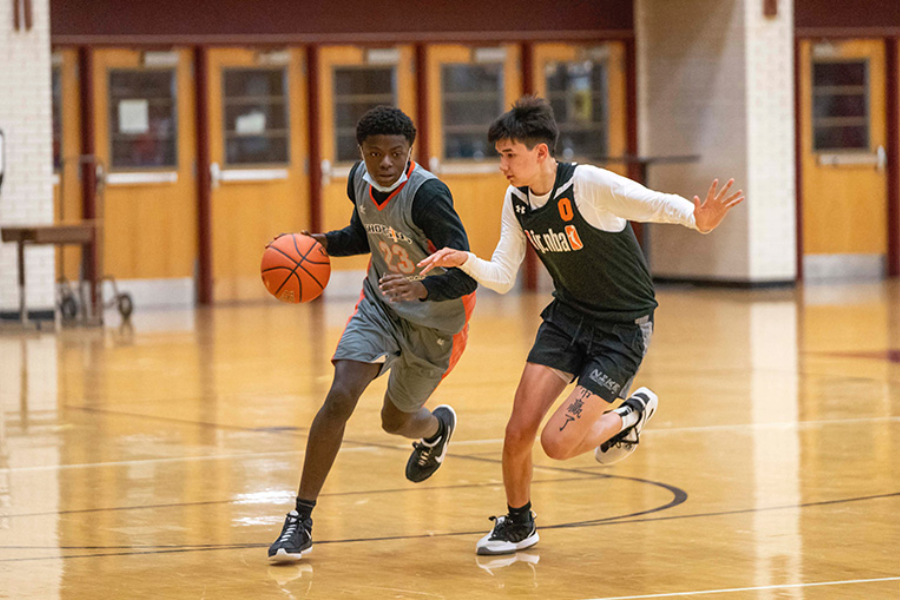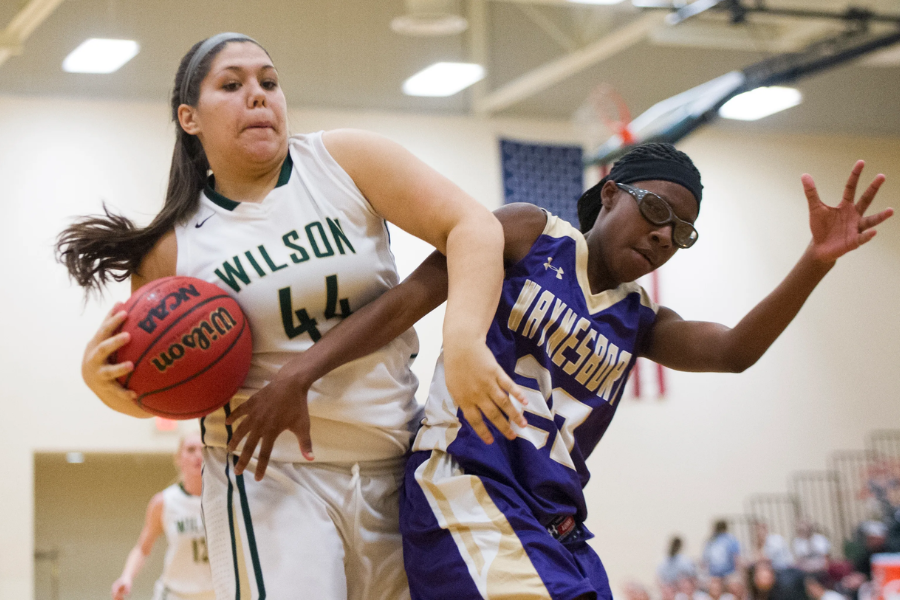What is AAU Basketball? Including Positives and Negatives
If you play sports, or know someone who does, chances are that you have heard of the AAU. Outside of school, it’s one of the best places for competing with athletes from all over your state. If you’re hearing for the first time about the AAU, I bet that your curiosity has been aroused. So what does AAU mean? Other than playing sports, what’s it all about? We have also compiled all you need to know about the AAU. But let us enter this organization on a deeper level. What is it and what does it contribute to sports?
What is AAU Basketball?
The Amateur Athletic Union is an organization formed to promote basketball. This group centers on encouraging kids and teens to play sports. In 41 different sports they have programs, so that young athletes can compete with the elite.
It’s even a union, with around 700,00 members and another 150.000 people working their way through it. They serve at 55 locations in the U.S., and hold that sport is an essential activity for everyone, so they advocate “ sports forever ” (e.g.). They wanted to let everyone, young and old alike learn to play sports properly.

In 2019, something big happened. The AAU also joined forces with the National Fitness Foundation. Together, they’re helping more American children play sports. The Presidential Youth Fitness Program is now handled by the AAU. This program is very much about making Gym class more fun by learning to be healthy and setting goals for oneself. In terms of sports and fitness for children, the AAU is the only group in this country that provides care both inside school hours and outside.
Today the AAU hosted some large events. Among these are the AAU Junior Olympic Games, a big sports event here. They also host the world’s biggest volleyball event for kids, the AAU Junior National Volleyball Championships. Every year, more than 2,700 teams come to play.
History of the AAU
The AAU was originally founded in 1888 within the New York Athletic Club. They have been awarding the best amateur athletes in the AAU James E. Sullivan Award – since the 1930s. For amateur sports, this award is a biggy.
As well as in world sports, they’ve been a big name and often represented the U.S. Then they concentrated on preparing young athletes for the Olympics. Then, in the 1970s, they switched to offering sports programs for people of all ages and fitness levels. But that’s not all they’ve done.
In 1996, the AAU teamed up with Walt Disney World and moved their main office to Orlando, Florida. They set up shop in the ESPN World of Sports Complex. Now, they hold over 60 AAU national events each year at the ESPN complex, and they share this space with the Atlanta Braves.

Who Can Play AAU Basketball?
AAU basketball is open to boys and girls alike. For example, boys can begin AAU basketball as early as 7 years old in the youngest age group. They’ll be able to continue playing through their school years, until they are in 12th grade. Afterwards there’s still an opportunity for them to play in the 19-and-under class. Girls, on the other hand, can start playing AAU basketball in the 2nd grade. Just like the boys, they may play all through school–until 12th grade. What’s more, the kids can also choose to play in a 19 and under league just like the boys. This inclusiveness thus provides opportunities for a broad spectrum of young athletes to enjoy AAU Basketball.
When is the AAU Basketball Season?
AAU Basketball’s main season is from February to July. This begins just immediately after the high school basketball season is over. However, there are also lots of tournaments being held all year-round, including in winter during the high school basketball season.
AAU basketball offers every age group a shot at achieving the national-championship tournaments. AAU is different from many other grassroots basketball programs, and these tournaments are a big reason why. These really do make AAU unique and give young players something enticing to look forward to.

Positives of AAU Basketball
AAU Basketball offers several significant benefits, despite some criticism:
Competing Against Top Players:
Playing against the best is one of the biggest benefits of AAU Basketball. You can’t really develop at basketball unless you come up against some strong competition, and AAU is just what it takes. It gives players the chance to test themselves against teams and players they wouldn’t encounter in the local leagues. This type of exposure is necessary. Facing such top-level competition serves not only to test players ‘ability, but also exposes their weaknesses. It allows players to know what they should work on and where their shortcomings lie.
Scholarship Opportunities:
If players have talent, AAU basketball is a key route to scholarship. Of course AAU isn’t a necessity for the top players, who already enjoy name recognition. But it is a game-changer for less well known players. The AAU tourneys have also given many athletes a chance to be discovered, earning them scholarships.
AAU provides these players the opportunity to play against top competition and before crowds of hundreds of college coaches. For players who haven’t been discovered by college recruiters, the AAU tournaments present an opportunity that they can’t afford to miss. That’s certainly a platform for them to get attention from coaches who might not go out of their way to watch them play in their hometown.
Additionally, AAU Basketball helps in:
Developing Teamwork and Social Skills: But the advantage of playing in AAU leagues and tournaments is that it teaches players to play as a team. They learn to play with all their coaches and teammates, adjusting to every kind of playing style and strategy possible. Such experience is highly beneficial to social and communication skills on or off the court.
Exposure to Diverse Playing Styles: Different playing styles AAU tourneys attract teams from different areas and styles. This diversity is good for the players because it helps them see a variety of basketball tricks and tactics in action, making them stronger and more versatile.
Building Competitive Spirit: AAU basketball is very competitive, and this has a positive effect on the player’s spirit of competition. This desire to perform and compete, at whatever level, is an essential component of any athlete’s development.
Potential for Personal Growth: Apart from basketball skills, AAU provides room for growth as a person. Discipline, dedication, and how to cope with both success and failure are necessary for players ‘all-around training in life.
Read more: What Is The Pick And Roll In Basketball? Tips For Executing

Negatives of AAU Basketball
AAU Basketball, while offering several positives, also has notable negatives:
Emphasis on Winning Over Player Development:
This emphasis on winning rather than developing basic basketball skills is one of AAU Basketball’s grievous shortcomings. But many coaches neglect the teaching of basic principles. Some teams don’t even regularly practice. The difficulty of organizing practice sessions is a problem that usually occurs whenever AAU teams try to whip up the top talent from far and wide.
When teams do get together, however, it’s all about tournaments in which the concentration is on playing several games a day rather than on developing skills. In addition, the strategy employed at tournaments of full-court presses and zone defenses which is used to win games results in players not receiving overall development. However these approaches don’t necessarily foster the development of versatile basketball skills, which is essential for long-term player development.
Prevalence of Poor Coaching:
The quality of the coaching is another important concern in AAU basketball. Becoming an AAU coach and forming a team is very easy. There are no criteria and no certifications. This results in a great variety of coaching skills. But unfortunately, this tends to make for defective coaching. Negative tactics by the coaches are not uncommon.
For instance, they would call the players names rather than constructively teach them. Coaching does require to a certain degree strictness and accountability. Yet, such tactics appear to be employed more for self-promotion or frustration by many coaches. Nor do they employ them as a method of player development. The problem is that this often harms both the development of young athletes and their enjoyment of the game.
Moreover, there are other issues worth mentioning:
Lack of Team Cohesion and Continuity: As teams have players from all over, naturally they are not too well coordinated. This is why collective play could be substituted for individual performance. That has nothing to do with learning how to use basketball in a team.
All these games and tournaments, with no time off for rest or recovery, leave players burned out. This can also lead to increases in overuse injuries. The AAU is so busy, however, that young athletes rarely get the rest and recuperation they need.
AAU Basketball provides exposure opportunities. But the competition is far from fair. It means that some of the players may dominate at this level without much of a challenge. Many others may find it difficult to pull themselves out of the wings.
The emphasis placed on victory and personal achievement may also influence the cultivation of sportsmanship. It also impedes further appreciation of the game. This may mean players miss out on experience in dealing with winning and losing, and the strategy of basketball.
Conclusion
AAU basketball gives these young athletes a chance to build up their abilities, receive exposure, and test their skills. Nevertheless, one must be realistic about the difficulties. It’s competitive here, and the risk of burnout is great. Players, parents and coaches must learn how to strike a balance between these positives and negatives. I hope this in-depth exploration of what AAU basketball is all about allows you to see how it affects young athletes ‘growth. It also highlights its influence on the future of basketball.
